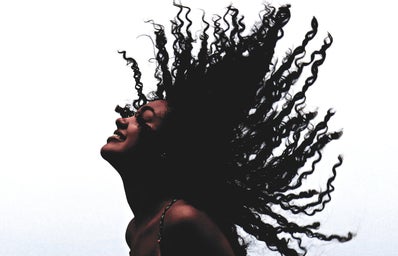A quick hair type categorizing breakdown: type 1 is straight, type 2s are wavy, type 3s are curly, and type 4s are coily. The hair types 2, 3, and 4 have subsequent A, B, and C divisions. My hair texture would be best described as 2C, which means it is quite wavy, but not tight enough to be defined as curly. Up until I was sixteen years old, I never knew how to properly take care of my hair. Most of the people I was surrounded by, including my family, had pin straight hair so I could not relate to them.
South Asian hair is entirely unique and generally falls into two sub-varieties. For instance, North Indians commonly have thick, straight hair and South Indians often have thick, curly hair. Unfortunately, many older women in this demographic tend to look down upon curly hair and brush it, only making it look worse.
What I often ended up doing was dry brushing my hair, which anyone with curly or wavy hair would tell you is a big no-no. My hair looked dry, frizzy, and puffy. Needless to say, it was not a good look on me. I then turned to straightening it constantly, which is another bad decision. It got to the point where I never felt pretty without straight hair, which is a mindset that no one should be in.
For the past year or so, I have been researching and finding ways to connect with my culture. Having strong, healthy hair is very prominent in South Asian culture, and I began to embrace my natural hair texture. Here is the hair routine I developed to keep my hair healthy and looking its best:
Step 1: Washing
I wash my hair twice a week. It is not good to wash your hair too often, but I find that my hair gets greasy if I wash any less. I would recommend using a clarifying shampoo once every other week to get rid of any natural or product buildup. This enables your hair to stay light, soft, and prevents the waves or curls from getting weighed down. I would also recommend conditioning the ends of your hair every time you take a shower.
Step 2: Combing
When you are out of the shower, use a wide tooth comb, a demnam, or a wet hair brush to remove any tangles, starting from the bottom and working your way up to prevent breakage. Your hair is most delicate when wet, so be gentle. At this point, you can add a leave-in conditioner to help with tangles and to keep your hair hydrated.
Step 3: Scrunching
When your hair is tangle-free and damp, add a mouse or gel to help define the curls. Section off your hair to divide the product evenly throughout, use prayer hands, and make sure to comb it through. Then, start scrunching! Grab small portions of your hair and squeeze them to your scalp. When you release them, a defined wave/curl should appear. Do this all over your head (a common method is to flip your hair over for easier access).
Step 4: Drying
There are a couple of common methods used to dry textured hair. These include: air-drying, diffusing/blow drying, and “plopping”. The first is pretty self-explanatory, but it’s just leaving your hair out and letting it dry throughout the day. Some people do not prefer this method because it can take your hair a long time to dry, wet hair can be uncomfortable, and it can weigh the hair down. The positive is that it prevents heat and weight damage to your hair.
My preferred method is to diffuse my hair. After I scrunch my whole head, I take portions of hair and use the diffuser attachment of my blowdryer to dry them. This attachment helps to reduce frizz by dispersing the air and maintaining the curl/wave pattern. I hate the feeling of having wet hair, so this eliminates that pretty quickly. I also find that my hair is bounciest with this method. Sometimes when you air dry your hair, it leaves product and water at the root which can cause it to become greasy faster. Even if you choose to air dry, I would still recommend using a blowdryer to dry your roots.
Finally, “plopping”, or drying your hair in a microfiber towel is another good option. You pile your hair up in a cotton shirt or towel, and wrap it around your head. There are many great videos that explain how to use this method. When you leave your hair down to dry, the weight of water and moisture in the hair can pull the curl pattern down before it can dry properly. This can leave the curls or waves in a loose, stretched state. Plopping works against this and can leave you with defined curls. Many people use this method as they are getting ready. The only drawback is that if you have a lot of heavy hair, it can weigh down your head, tugging at your hair, giving you a headache, and causing breakage.
Step 5: Styling
I use a hair serum or oil after my hair is dry to tame any frizz and flyaways. Always use a heat protectant if you are going to use heat on your hair. Be very wary of heat damage, as it can truly change the texture and appearance of your hair for the worse, so make sure to do it mindfully. Also, I would recommend using a hair mask, something as simple as coconut oil, once a week to stimulate hair growth and keep the hair healthy.



